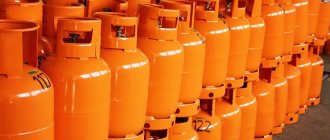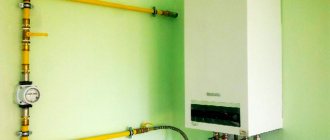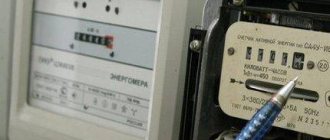Even the most careful and careful use of gas can lead to an accident. Its leak is a serious problem, which is vital to know about before the gas concentration in the room reaches a critical level.
A good gas leak detector with a shut-off valve is an almost irreplaceable device that can prevent a tragedy. Such a device not only signals an emergency situation, but also prevents its development by cutting off the fuel supply. After its installation, every home owner will feel more confident and calm.
In this material we will talk about the design of a sensor with a shut-off valve, consider the structure and principle of operation, and give practical advice on selection and installation.
Purpose of devices
The components of the gas have a slight harmful effect on the human body, but this is at normal concentrations. If the volume fraction of oxygen during inhalation decreases to 16%, suffocation occurs. If blue fuel does not burn completely, carbon monoxide (CO) is formed. The source of fumes can be a water heating column, a gas boiler or other equipment if the path through which combustion air is supplied is faulty, as well as the weak draft in the chimney.
Negative effects on the body
Carbon monoxide (CO) has a highly targeted mechanism of action on the human body, possibly leading to death. And since natural gas has no smell, taste or color, the risk of poisoning increases. In case of poisoning the following are noted:
- cardiopalmus;
- Strong headache;
- nausea accompanied by vomiting;
- cardiopalmus;
- dyspnea;
- dizziness;
- weakness.
In case of severe poisoning, convulsions and fainting occur. If the concentration in the air is more than 0.01%, this means imminent death within about an hour. (Qualified doctors will tell you about the details of the effect on the body)
To prevent such cases, gas sensors are installed. If gas alarms are installed in new residential premises where there is gas equipment (boilers, stoves, water heaters, etc.), then in previously constructed buildings it is necessary to install the device. Gas sensors should be triggered if the CO concentration in the room has reached more than 20 mg/m3 and the LEL content in the air is equal to 10%.
What else do you need to know about the main types of gas alarms?
If the device has a remote sensor, this allows the owner to remotely monitor gas pollution at a distance of 200 meters. This may include, for example, the basement where the boiler room is installed. Among other things, the owner can visually monitor the current situation; in this case, it is best to use a two-channel device of the SG-1 brand.
In some cases, there are multiple sources of gas accumulation or leakage. They can be removed from each other. In this case, you need to install sensors in each location. In this case, it is best to use the SGB-1 model. Each device is connected to an actuator similar to a gas valve. Manufacturers most often make the alarm housing from plastic, which is compact. On sale you can find designs of different colors and shapes, but it is recommended to focus on your own preferences, as well as the features of the interior.
The alarm at the sensor was triggered
Modern apartment alarms control fast shut-off valves, which are installed at the gas input point, and shut off the supply if a sensor signal is generated (the alarm is triggered). The devices are equipped with a built-in system that provides a sound and light signal, and also includes an autonomous unit for its supply - a detector. By placing a gas detector, a person promptly notices a gas leak and defects in the operation of the smoke removal system, which allows them to react in time and prevent an explosion, fire or carbon monoxide poisoning of people in the building.
It is not recommended to disable it yourself unless the cause is found. It is better to fix the problem with the gas service by calling 04 or from your mobile phone 040. Otherwise, remove the battery if the sensor is not powered from the network or turn off the device, and after ventilating the room, turn it on again.
Operating principle
The gas leak sensor is a compact device. Their work can be divided into two parts. The first is to detect critical gas levels in the room. This task is performed by the sensitive elements with which the device is equipped. The sensor takes in and passes air through itself, becoming an air analyzer. It turns out that if the concentration of harmful substances in the apartment is increased, then a signal is triggered. The second stage is human information about the critical gas concentration. Models equipped with communication channels are produced. For example, the owner of the house may receive a message on his phone. The sensor will continue to respond until corrective action is taken to correct the problem.
Best places to install
Any gas spreads throughout the house evenly, so it is advisable to place gas leak sensors in all areas of the apartment:
- Kitchen. In the kitchen, the device is fixed next to gas equipment, away from open fire.
- Living room. In this room, the device can be placed on the ceiling or side wall.
- Hallway. Also located either on the ceiling or on the side wall.
- Bedroom. It is the most vulnerable place in the house, since tired people sleep soundly in the bedroom. Here it is better to place the device above the front door.
- Loggia. The loggia requires the installation of two devices (propane and carbon monoxide), as well as an automatic shut-off valve.
- Commercial premises. When placing the alarm in commercial premises, the type of gas is taken into account. Appliances are placed above the ceiling if natural gas is supplied, or closer to the floor if there is a threat of carbon monoxide. Devices are usually mounted on walls, closer to gas equipment.
It is incorrect to install gas leak sensors behind curtains or blinds, in corners, or in closets - the device will not work correctly.
Gas sensor installation diagram
What are there
Gas detectors differ in the operating principle of the sensor. Semiconductor devices are produced in which the sensitive element is a silicon wafer coated with a thin layer of metal oxide on its surface. In such models, the gas is absorbed more strongly, therefore, the conductivity changes more. These devices are suitable for residential premises. Although not highly accurate due to their simple design, the sensors are inexpensive.
Catalytic alarms are manufactured that detect high levels of gas in the air by converting it into carbon dioxide and water. The air moves through the sensing element, which is a small coil made of platinum wire. The sensing element is coated with aluminum oxide, and a rhodium catalyst is located outside. When polluted air comes into contact with the catalyst, a kind of ignition occurs, during which the platinum wire heats up and its resistance changes. The more gas appears in the air, the more the wire heats up and its resistance becomes higher. These devices are highly accurate, respond quickly, but are more suitable for industrial premises. There are infrared gas leak detection devices that are suitable for low power industrial equipment.
You can purchase a wired or wireless device:
- Wired. They operate from a 220 V network. They are characterized by simplicity of design and fire safety, having elements of a high voltage electrical circuit inside. More used in industry.
- Wireless. They are installed mainly at home. Can be used in rooms where there is no electricity, as they are powered by built-in batteries. The wireless gas leak sensor can work in combination with a GSM alarm.
There are simple devices that are ideal for use at home. They are compact and easy to use. They are used in residential premises where people, having heard a sound signal, take action (call the emergency service, evacuate, close the valve).
The safest option . Devices that control shut-off valves are also produced. Complex devices that are capable of controlling a solenoid valve. As soon as the gas content in the air increases, the valve automatically moves to the “closed” position.
Principle of operation
Carbon monoxide sensors operate on the principle of air movement using natural convection. Air masses move through sensitive elements that are built into the equipment. When the permissible concentration of toxic substances increases, the carbon monoxide alarm sensor is triggered and gives an audible alarm, then the equipment is disconnected from the gas main, the hood, sirens, signal light panels begin to operate, and the alarm signal is transmitted via communication channels.
Installation Rules
Before installing a gas leak sensor in an apartment, you need to find a place so that access to the manual cocking is free. The device is installed in areas where leakage is more likely - in the immediate vicinity of the boiler, gas water heater, meter, stove. The distance to gas equipment is maximum 4 m.
Attention! When using natural gas - it accumulates under the ceiling - the sensor should be fixed at the top (30 cm from the ceiling). The liquefied liquid goes down, so the device should be installed as low as possible.
It is prohibited to place devices:
- near sources of open fire - a distance of at least 1 m;
- close to windows, ventilation systems, uninsulated chimneys;
- near places where droplets of grease, steam, or dust may appear;
- near flammable materials.
The installation height of a gas sensor in an apartment with an alarm system depends on its type. Household sensors are usually fixed using dowels - there are holes in their body. The passport of any product indicates the temperature at which operation is possible. After connecting the device, the green indicator should light up. If the connection is incorrect, an indicator of a different color (red, yellow) will light up and a sound signal will sound. If the sensor does not operate correctly, you should contact the technical support center.
When using the device, approximately once every three months you should clean it with a brush, but very carefully so as not to damage the structural elements.
Features of work
As soon as the gas supply is stopped and its concentration drops to normal, the signal will stop and auxiliary devices will be activated. After this, the indicator returns to normal measurement mode. As soon as the cause is eliminated, either on your own or with the help of the gas service, it will be necessary to restart the heating and heating equipment.
Popular and proven models
There are many models of gas leak sensors available. Popular among them are the following:
- Bradex Guardian. Budget device with alarm in the form of sound and flashing. The compact device is easy to operate.
- Bastion B40 DG. The popular wireless alarm is easy to use. When gas contamination is detected, the siren sounds. No additional setup required.
- Canary GD 100-CN . The Russian one continuously monitors the air condition in the apartment. The device has a manual testing mode. Provides sound and light indication and visual temperature control. The solenoid valve can be controlled.
- Sapsan GL-100. A model with a closing valve emits a loud squeak when the gas level in the air is higher than the permissible limit. Effectively ensures people's safety.
- Rubetek KR-GD13. The device informs about gas contamination on a mobile phone. In addition, a loud siren sounds. The compact model has a high-quality sensitive element. The compact and easy-to-use device is quite expensive.
- ALFA 501. Simple sensor with shut-off valve and equipped with an audible signal. The reliable and safe device has manual settings. Management is simple.
- Seltron RGDME5MP1. Efficient high-precision equipment from Italy. In addition to the sound alarm, a signal appears to activate the supply and exhaust ventilation. There are light indicators, a self-diagnosis system, and a solenoid valve that stops the gas supply.
- Brennenstuhl BG2202. A device with advanced functionality and a very loud sound signal. The high-quality compact device is easy to operate. The disadvantages include the high price.
- Crystal-1 . The one-component gas control device has advanced functionality. There is a control panel, light and sound alarms, and a shut-off valve.
You can find many models from other manufacturers (for example, here).
Need for use
A household carbon monoxide sensor is simply necessary when a family has a country house or house heated by boilers, stoves or fireplaces using liquid or solid fuel. The possibility of carbon monoxide accumulation when using this type of fuel is especially high. In some cases, there is a need to heat the house while the owners stay overnight. Experience in handling such devices that operate on solid or liquid fuels is often not enough. It is best to install a non-sleeping electronic sensor, which may be the simplest. Here we are talking about the SGB-1-4.01 brand.
The device will be sensitive to the accumulation of poisonous gases, and if such a situation occurs, it will sound an alarm. It is also important to note that all devices of the SGB-1 brand have LED sensors on the front panel, which visually allow you to determine what state the alarm is in at a certain moment.
Tips for choosing
To protect your home from increased gas pollution, you need to buy alarms based on certain rules. It is better to purchase a set from one manufacturer - all elements will fit together perfectly. Operation will also not cause difficulties. It is necessary to take into account:
- Total service life. It is indicated by the manufacturer in the instructions - it is different for all models.
- Service life of sensors - elements that are sensitive to gas. As a rule, their service life is much shorter than the devices themselves, so sensors need to be replaced more often. It is necessary to compare the costs of sensitive elements of different models.
- The gas protection system requires constant testing - checking its serviceability and readiness for operation . It is better to choose a device that can be tested simply by pressing a button.
- The documentation should indicate that the alarm has passed a meteorological test .
Also, alarms must be selected according to the following parameters:
- type of gas : carbon monoxide (CO), liquefied (butane-propane), natural (methane, CH4);
- by sensitivity : carbon monoxide – 20 mg/m3, fuel – 10 percent LEL;
- by type of sensors - work for identical gases can be implemented on various physical and chemical principles;
- the operating life of the device is at least 10 years;
- according to the service life of sensitive elements (replacement frequency 3.5 years).
You can also choose equipment with additional functions. For example, models are produced with a GSM module, thanks to which an instant notification is sent to the smartphone. You can choose equipment with self-diagnosis and interference indication. There are models that have contacts that allow you to turn on the exhaust fan.
Since many explosions and fires occur due to gas leaks, it is necessary to install a gas leak detector in your apartment or home. Placing a small device in your home will save you from tragedy and preserve the health of you and those close to you.
What are there
Nowadays, different gas leak detectors are sold on the market, they are divided according to the principle of operation, the type of sensitive element and the type of gas detected (carbon monoxide, carbon dioxide and natural gas). The principle of operation means that there are wired devices that connect to a 220-volt network, and there are wireless devices. Their functioning depends on the battery, which is very convenient when the electricity in the house is turned off.
There are three types of sensing element: semiconductor, catalytic and infrared. The most inexpensive ones are those with a semiconductor element; they are most often purchased by ordinary property owners. Catalytic analyzers are used at large industrial enterprises; their action is based on the combustion of gas and its decomposition into carbon dioxide and water. Infrared devices pass the gas through their beams and determine the excess concentration with extreme accuracy.
Carbon monoxide detector for home: details about the leak detection device
The severity of poisoning depends on the amount of carbon monoxide in the room:
- When the level increases to 0.32%, loss of consciousness, coma and paralysis occur due to oxygen starvation, and death occurs within half an hour.
- Then a headache and dizziness begin, and a cough appears.
- With a CO content of 0.08%, the first symptoms of poisoning are mild malaise and drowsiness.
- In especially severe cases, damage to the mucous membranes of the nasopharynx, paleness of the skin and disruption of the heart are observed.
- If the gas level rises to 1.2%, the person dies within 3 minutes.
Leakage of the substance occurs mainly in private buildings due to malfunction of ventilation and chimney ducts.
In addition, gas appliances, boilers and other equipment often fail, and as a result, the CO level in the room rises.
Carbon monoxide detector for home: details about the leak detection device
Symptoms of CO poisoning do not appear immediately, and the gas itself is invisible, colorless, tasteless and odorless. For a sleeping person, the poisonous effect of a toxic substance in some cases results in death.
A person who inhales carbon monoxide loses consciousness and dies after a while from lack of oxygen. Therefore, installing a carbon monoxide detector in your home becomes a must for safety.
A high concentration of carbon monoxide (carbon monoxide) in the air can not only kill a person, but also provoke an explosion. CO is released during incomplete combustion of flammable materials and substances such as coal, kerosene, oil, wood, propane, and natural gas.
Equipment with an internal combustion engine (compressors, lawn mowers, chainsaws) also emit dangerous carbon monoxide during operation.
Operating rules
After installation, it is worth observing the device for some time.
For efficient and correct operation of the device, it is important not only to install it correctly, but also to properly care for it:
- Regularly wipe off dust from the device, but do not overdo it so as not to damage the sensor;
- do not allow the surface to become clogged;
- periodically test the sensor, for example, with gas from a lighter;
- If a model with a valve is installed, periodically check it for operation.
Attention! After checking the operation of the shut-off valve, do not forget to return it to its operating position.
Types of shut-off valves
A smoke and carbon monoxide detector used with shut-off valves may require different types of attachments. If we are talking about a valve, then it may be NO, which implies a normally open device. Sometimes you can find a normally closed device. In the first case, no voltage is supplied to the device, and the valve is constantly open, which indicates the free passage of gas. If you decide to purchase carbon monoxide sensors, you can read the operating principle of this equipment in the article. But the valve for it can also be electromagnetic. When choosing it, the consumer should pay attention to the intended location of this element. In most cases, such systems are recommended to be installed on horizontal pipelines, as this is required by the design of the device.
In some cases, the approach under consideration is not possible, because the supply pipeline is vertical. In this case, you can choose an electromagnetic gas valve of the KEI-1M brand. Its main advantage is the possibility of installation on vertical and horizontal pipelines. Consumers also choose these elements because of their fairly attractive cost.
Safety
Operation of this equipment is permitted in full accordance with the operating instructions and only in good condition.
Incorrect use and non-intended use are dangerous to the health and life of users. Work related to electrical connections must only be carried out by qualified and trained personnel in accordance with the installation regulations and requirements.
The device itself and the surrounding area must be kept clean, have easy access and be clearly visible.
If a leak is detected, ensure sufficient ventilation in the room and call the emergency gas service. Before their arrival, you must not turn on electrical appliances or use open fire.











